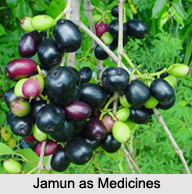 Jamun has many medicinal properties and its fruit is very rich in nutrients. There is lot of medicinal use of Jamun in Ayurveda. Botanically known as Eugenia Jambolana, its appearance coincides with the season"s first showers. This tree, which yields an abundant crop of sub-acid edible fruits during the months of July and August, is common all over the country. In some places the fruits attain the size of a pigeon"s egg and are of superior quality.
Jamun has many medicinal properties and its fruit is very rich in nutrients. There is lot of medicinal use of Jamun in Ayurveda. Botanically known as Eugenia Jambolana, its appearance coincides with the season"s first showers. This tree, which yields an abundant crop of sub-acid edible fruits during the months of July and August, is common all over the country. In some places the fruits attain the size of a pigeon"s egg and are of superior quality.
Dose of Jamun in Medicine
Its fruit, leaves as well as seeds are main part which can be used in curing and controlling diseases. A vinegar prepared from the juice of the ripe fruit, is an agreeable stomachic and carminative. It is also used as a diuretic in scanty or suppressed urine. A sort of spirituous liquor called "Jambava" is described in recent Sanskrit works as prepared by distillation from the juice of the ripe fruits.
The bark is astringent, and is used alone or in combination with other medicines of its class, in the preparation of astringent decoctions, gargles and washes. The fresh juice of the bark is given with goat"s milk in the diarrhoea of children.
The expressed juice of the leaves is used alone or in combination with other astringents in dysentery with bloody discharge, as for example in the following prescription. Take the fresh juice of the leaves of jamun, mango and emblic myrobalan about a drachm each, and administer with goat`s milk and honey.
This article is a stub. You can enrich by adding more information to it. Send your Write Up to content@indianetzone.com
Related Articles
Ayurveda
Origin of Ayurveda
Ayurveda Medication
Elements of Ayurveda
Concepts of Ayurveda
Ancient Literature of Ayurveda
Sushruta Samhita




















